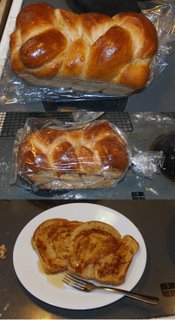
A friend sent me a link an article about
No Knead Bread. So what did I do? Went out and bought an enameled stock pot so I'd have an oven safe container with a lid the proper dimensions for this recipe. The
recipe itself is simple, although I translated it from 3 cups flour to 1 lb of bread flour,and 1 5/8 cup water into 13 oz. With only 4 ingredients, it's easy. So my 4 year old and I yesterday mixed together
1 lb bread flour
1 1/4 teaspoon salt
1/4 teaspoon instant yeast
13 oz water
After bringing it together we covered the bowl with plastic wrap and set aside to proof overnight. The recipe said 12-18 hours minimum, 24 hours even better.
Today I shaped the loaf around 10am, generously covering it with corn meal to prevent sticking. It's a really wet dough, I warn you now. Around 12:30pm I put the stock pot and lid into the oven for preheat. I gave it about 20 minutes to thoroughly heat to 450 degrees, then removed the pot from the oven and tossed in the dough, recovered and put back.
20 minutes into the baking it smelled wonderful. 30 minutes in I removed the lid for the last 15 minutes. Put the lid on the stovetop for cooling, it was handleable 15 minutes later when the bread came out. I dumped the loaf onto a cooling rack and set the stock pot aside for cooling. After an hour I photographed and cut into the loaf, revealing large air bubbles and a slightly chewy texture, quite good. I am ranking this among my favorite recipes, both for the ease and for the flavor of the bread.
Recipe archive
Recipe: No-Knead Bread
Published: November 8, 2006
Adapted from Jim Lahey, Sullivan Street Bakery
Time: About 1½ hours plus 14 to 20 hours’ rising
3 cups all-purpose or bread flour, more for dusting
¼ teaspoon instant yeast
1¼ teaspoons salt
Cornmeal or wheat bran as needed.
1. In a large bowl combine flour, yeast and salt. Add 1 5/8 cups water, and stir until blended; dough will be shaggy and sticky. Cover bowl with plastic wrap. Let dough rest at least 12 hours, preferably about 18, at warm room temperature, about 70 degrees.
2. Dough is ready when its surface is dotted with bubbles. Lightly flour a work surface and place dough on it; sprinkle it with a little more flour and fold it over on itself once or twice. Cover loosely with plastic wrap and let rest about 15 minutes.
3. Using just enough flour to keep dough from sticking to work surface or to your fingers, gently and quickly shape dough into a ball. Generously coat a cotton towel (not terry cloth) with flour, wheat bran or cornmeal; put dough seam side down on towel and dust with more flour, bran or cornmeal. Cover with another cotton towel and let rise for about 2 hours. When it is ready, dough will be more than double in size and will not readily spring back when poked with a finger.
4. At least a half-hour before dough is ready, heat oven to 450 degrees. Put a 6- to 8-quart heavy covered pot (cast iron, enamel, Pyrex or ceramic) in oven as it heats. When dough is ready, carefully remove pot from oven. Slide your hand under towel and turn dough over into pot, seam side up; it may look like a mess, but that is O.K. Shake pan once or twice if dough is unevenly distributed; it will straighten out as it bakes. Cover with lid and bake 30 minutes, then remove lid and bake another 15 to 30 minutes, until loaf is beautifully browned. Cool on a rack.
Yield: One 1½-pound loaf.
 The blob loaf is covered in corn starch, which I made way too thick. Forgive me, it wasn't the smartest move I've made while bread baking. I considered it a throwaway piece anyway.
The blob loaf is covered in corn starch, which I made way too thick. Forgive me, it wasn't the smartest move I've made while bread baking. I considered it a throwaway piece anyway.









